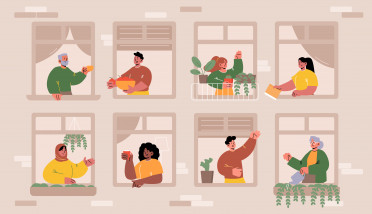The art of being a neighbor in France defined by social position and place of residence
Thirty-five years after the last major national survey on relations between neighbors in France (INED/INSEE “Contacts” survey, 1983), a new survey, entitled “Mon quartier, mes voisins” [My neighborhood, my neighbors], has studied those relations at different scales and documented individuals’ social integration at local (the immediate neighborhood) and extra-local (outside the neighborhood) levels. For the new survey, conducted in spring 2018, 40 interviewers collected 2,572 questionnaires (each taking an hour on average to administer) from a representative sample of inhabitants of 14 neighborhoods in the Paris and Lyon metropolitan areas.
Being neighbors: an important social activity
The survey found that the neighborhood is still an important locus of individuals’ social life in France, a place where services are exchanged, a place of friendly visits and gatherings and informal conversations. In the 14 neighborhoods studied, 82% of inhabitants had visited or invited over someone living in their apartment building or neighborhood in the preceding twelve months, 77% had given or received some kind of help in their neighborhood, 40% had exchanged information on schools with other neighborhood residents, and 23% had shared information about job opportunities. Moreover, 8% had found their current job thanks to neighborhood social ties, and 22% say they feel they can count on a neighbor in case of a financial problem. Only 6% of individuals have no social ties in their neighborhood of residence.
Social ties defined by social position
Social interactions within neighborhoods vary by socio-occupational category and residence address. In all contexts, highly educated inhabitants and inhabitants with high incomes interact with their neighbors more than others. We do observe some exceptions to this hierarchy though: craftspeople, tradespeople, and care and personal service workers (including women childcare providers, women apartment building managers, and women cleaners) are particularly implicated in neighborhood social relations. Differences between social groups are accentuated by differences in residential context: social relations are denser and more intense in upper-class and gentrified neighborhoods than rural towns. Conversely, in the centers of smaller French cities in decline and in urban housing developments under renovation, the proportion of isolated individuals is higher and relations sparser.
Cumulation of neighborhood relations and social ties outside the neighborhood
The survey’s comparative study of social ties within and outside of the immediate residential area call into question the assumption of a compensation phenomenon, i.e., the notion that social ties forged in a given space exist in opposition to relations in other ones, or that local and extra-local social ties are “made at the expense of one another,” either because individuals have limited free time or feel a lack or “hole” in their social relations. The results of this survey run contrary to that hypothesis, finding that the same individuals invest heavily in both local and extra-local social relations. In sum, neighborhood-based and non-neighborhood based relations do not compensate each other, most of the time they cumulate. This mechanism works to the advantage of privileged inhabitants of wealthy and gentrified neighborhoods: they accumulate social capital in all contexts. At the other end of the social scale, the working class (approached by way of socio-occupational category, and encompassing some white-collar workers together with blue-collar workers and economically inactive persons) and inhabitants of declining inner-city neighborhoods are at a disadvantage on all counts.
However, certain social categories and contexts qualify this picture. While craftspeople, tradespeople, and care and personal service providers invest heavily in local social relations, they invest relatively little in extra-local ones. The situation of single-parent families is similar: that particular situation makes involvement in local solidarity networks more likely for them, while making social relations outside the neighborhood much less so. Conversely, young people constitute a social category for whom low investment in local social ties is compensated by a dense concentration of social relations in other places.
Extra-local ties of immigrants and residents of working-class neighborhoods
In France—where the idea that ethnic or immigrant groups live almost exclusively among themselves often arises in the media as a political issue—the “My neighborhood, my neighbors” survey is the very first to document the local and extra-local ties of immigrants in comparison with other social groups. It is therefore the first to provide evidence that the notion of immigrants living and socializing among themselves in their own communities (communautarisme in French) is unfounded. Immigrants do have fewer extra-local social ties than other groups, including when include their contacts with people living abroad are included. But they also have fewer contacts within their neighborhoods. Another important finding: immigrants’ specificities are due solely to their socio-economic status situation (qualifications, income, occupation), on which basis they belong—more often than others—to the working class. When sociodemographic characteristics are controlled for, there is no difference between immigrants and the majority population.
The situation is different for the children of immigrants, however, who often have higher qualifications than their parents. Their improved social position is reflected in greater investment in local relations compared to their parents. Still, because this category continue to be targets of stigmatization and discrimination, have difficulty developing ties outside the neighborhood.
In conclusion, the dynamics of social ties in France both reflect and reinforce social and geographic inequalities. The socially and geographically underprivileged working-class (classe populaire in French) develop fewer ties within and outside their neighborhood, not because they are not interested in such ties but because they do not have the resources to forge and maintain them. This situation accentuates social and geographic inequalities, despite the fact that the values, norms, and aspirations of working-class people in France are less and less different from those of other social groups.
Source :
Joanie Cayouette-Remblière et Eric Charmes, 2024, "Social ties in and out of the neighbourhood: Between compensation and cumulation", Urban Studies
Contact : Joanie Cayouette-Remblière
Online: august 2024

